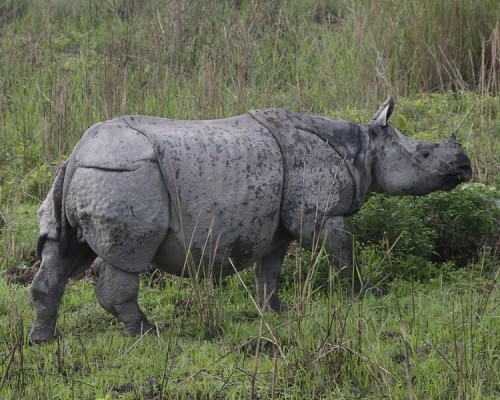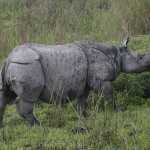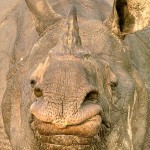
A local volunteer in Assam’s Indian Rhino Vision 2020 has been named as the “prime suspect” in the killing of a rhino on August 6, 2013, in Manas National Park.
Police are searching for Munindra Basumatary (aka “Hongalla”) and have already arrested his brother, Lakshman Basumatary, for “possessing rhino meat, bones, teeth and hide” at his house at Daoraibari village near the park. Another suspect, Sukhram Swargiary, has also been arrested. A senior forest official told the Times of India that “Hongalla was absent from duty for almost a week before August 6. But he arrived on the day postmortem was conducted on the carcass”. The brothers may also be linked to an earlier incident.
During the raid, rhino meat, bones, teeth and dried hide of a rhino poached in January this year were recovered from Lakshman’s house. During interrogation, Lakshman revealed that Hongalla was involved in the August 6 poaching.
A park official who wished to remain anonymous said that the involvement of an IRV volunteer “has come as a big shock” but added that “motivational assessment of the volunteers was not done”, according to The Assam Tribune.
The six-year-old male rhino was missing his horn, ears, nail, and tail. He had been translocated from Kaziranga National Park to Manas in March 2012. A total of five rhinos have been killed in Manas National Park since 2011; three of the killings have occurred this year.
A “growing presence of armed militants” in Manas National Park, possibly linked to the National Democratic Front of Bodoland (NDFB), has raised safety concerns about NGO staff working in the park. Meanwhile, fourteen camera traps have gone missing.
Fourteen camera traps in the area were found missing recently — something attributed to militants who are increasingly using the cover of the jungle for their activities, including cross-border movement to Bhutan.
Several years of deadly civil conflict — which extirpated its original rhino population — caused Manas National Park to be added to the World Heritage Committee Danger List in 1992. However, significant improvements enabled Manas to regain its status as a UNESCO World Heritage site in 2011.




